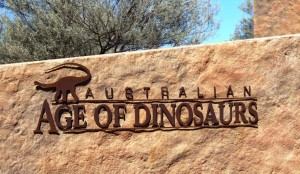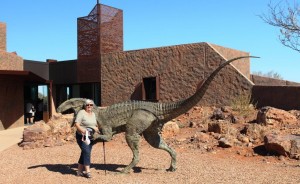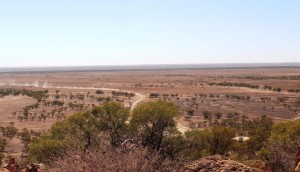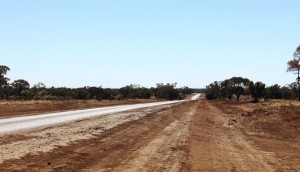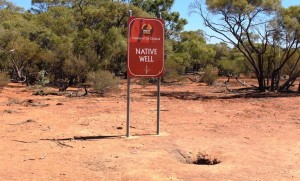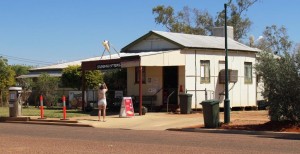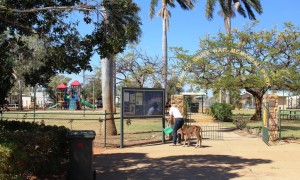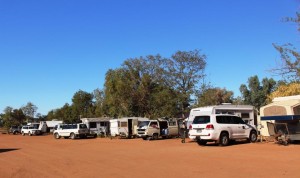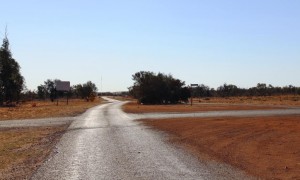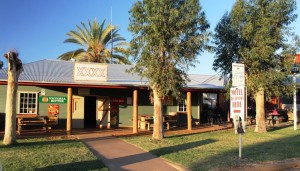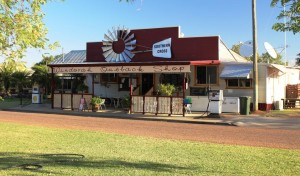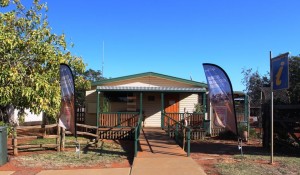We made an early start from Porcupine Gorge. Squally winds had roared through the trees all night so we were awake early and took advantage of the situation. The road back to Hughenden was a downhill run most of the way assisted by a brisk following wind. Refuelling in Hughenden took only a few minutes and we departed this pleasant town for Winton, the remaining corner of the Dinosaur Triangle. From Hughenden it is a run of 212 kilometres over flat grazing land on a single lane sealed road with some wider passing sections. We made two stops, the second of them at a place called Corfield pronounced the same as Caulfield in Victoria. And like its differently spelled namesake it runs, annually, a race meeting with – you guessed it – a Corfield Cup. The town contains a pub, two houses, a rest stop and, of course, a race track.
We had spent time at Winton in 2009 during our Big Lap and although there are still things that we want to do they could not be fitted into this trip. However, we did fill one gap by dining in Banjo’s Bar where the park offers a nightly three course dinner and then enjoyed the entertainment of Suzie the resident comedian bush poet. A great night’s entertainment provided by a very funny lady.
The third corner of the Dinosaur Triangle is provided in part by the Australian Age of Dinosaur Centre located about 20 kilometres out of Winton. The other dinosaur highlight is Lark Quarry, the sight of the dinosaur stampede. But we saw that in 2009 and a repeat was not a possibility, or of interest for that matter. The turn to the Age of Dinosaur is on top of a mesa, or jump up, just 13 kilometres on the road to Longreach. Gravel starts immediately you leave the highway, so we followed the dusty road across the flat lands and up the jump up to the very adequate parking area. The facility was quite new and very modern. There is a shop, coffee shop and display at this sight. About 500 metres away there is a laboratory where restoration work is done.
The tour covers both locations but takes about 90 minutes and costs $28 each for seniors. This tested the level of our interest in pre-historic creatures. Coffee and cake won out. After partaking we returned to the low lands and made our way to Longreach. It is an easy drive. The road is reasonably wide and quite flat, although we initially climbed slowly from the Diamantina and then descended to the Thomson.
At a couple of locations quality facilities have been provided including regularly maintained toilets, spacious picnic shelters and enough space for overnight campers to keep out of each others hair. We arrived to find the caravan park in which we had stayed last time greatly enlarged. We had a site with the caravan between ourselves and the sun. This was most welcome as the temperature was around the mid 30s by mid-afternoon.
Our original intention had been to continue along the Landsborough Highway until it became the Capricorn Highway at Barcauldine. From there we had intended to visit the gem fields of Sapphire and Rubyvale before turning for home. But back along the road a bit we had changed our minds and decided to continue south. Well, south west actually. So on departure next morning, after a brief shopping excursion, we called to look at the well known, among its adherents, free camping area beside the Thomson River.
We found a few vans in a spacious area beside a river that contained much more water than we had expected. This is, of course, one of the wonders of the main waterways in the Channel Country. They have an ability to hold large pools of water for very long periods during hot weather.
The Longreach Windorah Road follows the Thomson River between these towns, although most of the journey the river is out of sight. This is grazing country, mostly cattle but with some sheep for wool and meat production. The road is mostly unfenced and there are numerous cattle grids across the road. We saw some stock but not much as conditions are dry out there and areas of pasture are rested regularly and for long periods, so the stock could be somewhere else on the property. Of the 314 kilometres length of this road, most runs through the Barcoo Shire. This remote municipality of just 460 people covers 62,000 km2. The Thomson River runs through its length and is joined by the Barcoo in the south. Jointly they become Cooper Creek which flows, sometimes, into Lake Eyre.
We paused for morning tea at the roadside and then continued to the mini town of Stonehenge. This tiny community of about 100 people has, of course, a pub but no store, and it has a caravan park. The council has installed power heads, an amenities block with toilets, showers and a washing machine. Visitors may stay by paying, by an honesty system, $10 per night.
Soon after leaving Stonehenge the road rose steeply and levelled to a plateau. There, by the side of the road, is a well that indigenous people used as a water supply for who knows how long. Water is visible about 25 cm below the ground.
The next town is along this road is Jundah, the adinistrative centre of the Shire. It has about the same population as Stonehenge but appears to be a bit more substantial. It has a small store but no obvious fuel supply. There is a school and a police station. A small caravan park operates providing an alternative to the free camping areas on the banks of the Thomson. Beside the park, which is also the war memorial, the council has built a quality amenities block for the use of campers and other members of the travelling public.
The road crosses the Thomson River at Jundah and continues through flat riverplains until the Diamantina Developmental Road is reached just east of Windorah. Which, of course, brings us to the third of the three towns that comprise the urban areas of the Barcoo Shire.
Windorah is the last town before Birdsville which is 388 kilometres further along the Diamantina Develpmental Road and the Birdsville Developmental Road. The greater part of the 200 kilometres of the Birdsville Developmental Road is sand, dirt and gravel. Consequently Windorah has businesses that offer succor to both traveller and vehicle. Long term blog readers will remember our failed attempt to reach Birdsville via the Birdsville Track in 2011 when we were thwarted by rain. We have not had the opportunity to try again so you can imagine my feelings as I gazed along that part of the road out of town that I could see from the gate of the caravan park.
The caravan park is operated by the council and it is another low cost park. Just turn up and sellect a site and a council employee will find you and collect $10 per van or tent. The amenitius were solid but very useable. Surprisingly it was possible to produce a lather under the shower. Our visit coincided with the annual pilgrimage to the Birdsville cup. Most of our fellow campers were headed there together with most of the several hundred vehicles that we met as we travelled east over the next couple of days. We heard estimates of 8,000 to 10,000 revellers at Birdsville for the Cup. In a town with a permanent population of less than 300 this is not the time of the year that I would want to visit.
Windorah does not look to be a prosperous town but it must be. Every person who passes through spends money there. Most vehicles would need to refuel and many would top up supplies. The hotel offers rooms and cabins and there is another establishment that offers cabin accommodation.
The normal flow of travellers south on the Birdsville Track and west over the Simpson Desert grows annually. In addition, increasing numbers are travelling this way to the Red Centre through Windorah to Bedourie and Boulia and then over the Donohue and Plenty Highways to Alice Springs. Councils, understanding the value of the tourist dollar, are putting more effort into road maintenance which means more regular grading. The dust is much easier to take if it doesn’t have bumps under it.
We were were much impressed by the effort by the Barcoo Council to encourage tourism. Not only are the caravan parks inexpensive, adequate and well maintained but the roads are in much better condition than in the neighbouring shires of Longreach and Quilpie. The quality of the roads literally change at the boundary. Barcoo puts great effort into keeping the shoulders graded with soil packed right to the edge of the single lane sealed strip. This reduces the risk of damage to tyres significantly.The only thing missing from the three Barcoo towns that would be useful is mobile phone coverage. With this service available we would return and spend a while. The camping places along the Thomson and Cooper looked quite attractive.
This was to have been the last blog in this series but I have too much material that won’t fit in. So watch out for the final part of the story as we share our trip home from Windorah.

